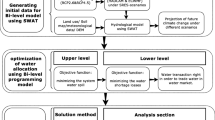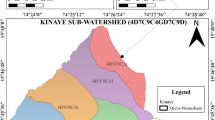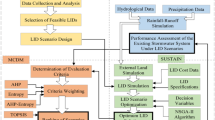Abstract
Flood mitigation measures are aimed at reducing adverse flooding impacts. Flood source control schemes mainly concentrate on biological soil and water conservation measures (SWCMs) including the revival and preservation of soil and land use. Such activities prevent splash erosion, reduce the velocity of surface runoff, increase surface roughness that in turn improve infiltration and control soil erosion. Nevertheless, based on technical and budget constraints, uniform implementation of biological SCWMs is neither practical nor optimal. Previous studies on spatial optimization of BMPs (best management practices) have mostly focused on urban structural and/or biological BMPs. Besides, the incorporation of land use/cover and slope maps in source control site selection has not been thoroughly studied. In this research, cover–slope zones are proposed as spatial units for spatial optimization of biological SCWMs. The objective of this study was to determine the optimal spatial distribution of SWCMs using coupled simulation–optimization models. A fully distributed event-based deterministic hydrologic rainfall–runoff model was developed that involved SCS-CN (soil conservation service curve number), ModClark and Muskingum as infiltration, rainfall–runoff and stream routing model, respectively. Genetic algorithm was adopted to search the optimized areas based on two objective functions: minimization of the outlet peak discharge and the cost. Nardin sub-catchment in northern Iran was selected as the case study. For different degrees of flood peak reduction under 100-year design rainfall, the optimal patterns identified by the optimization algorithm were a combination of less effective/costly options (exclusion) and the most effective option (transplant). Accordingly, biological SCWMs were assigned from the farthest zone to the outlet, stretching into downstream zones.











Similar content being viewed by others
References
Ahmadisharaf E, Kalyanapu AJ, Chung E-S (2015) Spatial probabilistic multi-criteria decision making for assessment of flood management alternatives. J Hydrol. https://doi.org/10.1016/j.jhydrol.2015.12.031
Akhtari R, Saghafian B, Samani MVJ, Ghermez cheshme B (2012) Determinant of optimal land use change scenario to reduce peak runoff flow based on a proposed cost-benefit relationship. J Manage Syst 5(14):17–28
Ansari V (2009) Technique and principles of the rangeland improvement and development project. forests, Range Watershed Manag Organ 168
Antolini F, Tate E, Dalzell B, Young N, Johnson K, Hawthorne PL (2020) Flood risk reduction from agricultural best management practices. JAWRA J Am Water Resour Assoc 56(1):161–179. https://doi.org/10.1111/1752-1688.12812
Behroozi A, Niksokhan M, Nazariha M (2018) Developing a simulation-optimization model for urban run-off control. J Flood Risk Manag 11:S340–S351. https://doi.org/10.1111/jfr3.12210
Ciou KS, Kuo TJ, Hsieh PH, Yu GH (2012) Optimization model for BMP placement in a reservoir watershed. J Irrig Drain Eng 138:736–747
Molden D (2007) Water for food, water for life: a comprehensive assessment of water management in agriculture. Earthscan, and colombo international water management institute, London
Depeng Y, Jiping W, Yongbing L, Xiaoli Z, Hailong L, Jie W (2009) Ecologically based landscape pattern optimization in Northwest of Beijing. J Geograph Sci 19:359–372
Hand Book of Hydrology (1972) Soil and water conservation department. Ministry of Agriculture, New Delhi
Heydari F, Saghafian B, Delavar M (2016) Coupled quantity-quality simulation-optimization model for conjunctive surface-groundwater use. Water Resour Manag 30:4381–4397
Honghai Q, Altinakar MS, Vieira DAN, Alidaee B (2008) Application of tabu search algorithm with a coupled AnnAGNPS-CCHE1D model to optimize agricultural land use. J Am Water Resour Assoc 44:866–878
Huff FA (1990) Time distributions of heavy rainstorms in Illinois. In: Illinois state water survey, circular 173. Illinois state Water survey, Champaign
Kaini P, Artita K, Nicklow JW (2012) Optimizing structural best management practices using SWAT and genetic algorithm to improve water quality goals. Water Resour Manag 26:1827–1845
Kundzewicz ZW, Takeuchi K (1999) Flood protection and management: quo vadimus. J Hydrol Sci 44(1):417–432
Mahmood K, Qaiser A, Farooq S, Nisa M (2020) RS- and GIS-based modeling for optimum site selection in rain water harvesting system: an SCS-CN approach. Acta Geophys. https://doi.org/10.1007/s11600-020-00460-x
Oraei ZS, Saghafian B, Shamsai A (2012) Multi-objective optimization for combined quality–quantity urban runoff control. Hydrol Earth Syst Sci 16(12):4531–4542
Qi H, Qi P, Altinakar MS (2013) GIS-based spatial monte carlo analysis for integrated flood management with two-dimensional flood simulation. Water Resour Manag 27(10):3631–3645. https://doi.org/10.1007/s11269-013-0370-8
Qin C-Z, Gao H-R, Zhu L-J, Zhu A-X, Liu J-Z, Wu H (2018) Spatial optimization of watershed best management practices based on slope position units. J Soil Water Conserv 73(5):504–517
Reichold L, Zechman EM, Brill ED, Holmes H (2010) Simulation-optimization framework to support sustainable watershed development by mimicking the predevelopment flow regime. J Water Resour Plan Manag 136(1):366–375
Saadat H, Adamowski J, Bonnell R, Sharifi F, Namdar M, Ale-Ebrahimc S (2011) Land use and land cover classification over a large area in Iran based on single date analysis of satellite imagery. ISPRS J Photogramm Remote Sens 66:608–619
Saghafian B, Golian S, Ghasemi A (2014) Flood frequency analysis based on simulated peak discharges. Nat Hazards 71(1):403–417. https://doi.org/10.1007/s11069-013-0925-2
Saghafian B, Noroozpour S, Kiani M, Rafieei Nasab A (2016) A coupled ModClark-curve number rainfall-runon-runoff model. Arab J Geosci 9(4):1–13
Saghafian B, Golian S, Elmi M, Akhtari R (2013) Monte Carlo analysis of the effect of spatial distribution of storms on prioritization of flood source areas. Nat Hazards 66(2):1059–1071
Shifa MA, Jianhua HE, Feng LIU, Yan YU (2011) Land use spatial optimization based on PSO algorithm. J Geo Spat Inf Sci 14:54–61
Shirazi MM, Khademalrasoul A, Safieddin Ardebili SM (2020) Multi-objective optimization of soil erosion parameters using response surface method (RSM) in the Emamzadeh watershed. Acta Geophys 68:505–517
Simonovic S, Nirupama N (2005) A spatial multi-objective decision-making under uncertainty for water resources management. J Hydroinform 7:117–133. https://doi.org/10.2166/hydro.2005.0011
Sultan D, Tsunekawa A, Haregeweyn N, Adgo E, Tsubo M, Meshesha DT, Masunaga T, Aklog D, Fenta AA, Ebabu K (2018) Impact of soil and water conservation interventions on watershed runoff response in a tropical humid highland of Ethiopia. Environ Manag 61(20):1–15. https://doi.org/10.1007/s00267-018-1005-x
World Meteorological Organization (2011) Manual on Flood Forecasting and Warning, (WMO-No. 1072), Geneva
Wu H, Zhu A, Liu J et al (2018) Best management practices optimization at watershed scale: incorporating spatial topology among fields. Water Resour Manag 32:155–177. https://doi.org/10.1007/s11269-017-1801-8
Yazdi J, Salehi Neyshabouri SAA, Niksokhan MH, Sheshangosht S, Elmi M (2013) Optimal prioritisation of watershed management measures for flood risk mitigation on a watershed scale. J Flood Risk Manag 6(4):372–384. https://doi.org/10.1111/jfr3.12016
Yeo IY, Guldmann JM (2010) Global spatial optimization with hydrological systems simulation: application to land-use allocation and peak runoff minimization. Hydrol Earth Syst Sci 14:325–338
Zhai Q, Rahardjo H, Satyanaga A (2017) Estimation of air permeability function from soil-water characteristic curve. Can Geotech J 56(4):505–513. https://doi.org/10.1139/cgj-2017-0579
Zhai Q, Rahardjo H, Satyanaga A (2019) Role of the pore-size distribution function on water flow in unsaturated soil. J Zhejiang Univ Sci A 20:10–20. https://doi.org/10.1631/jzus.A1800347
Zhai Q, Rahardjo H, Satyanaga A (2020) Framework to estimate the soil-water characteristic curve for soils with different void ratios. Bull Eng Geol Environ 79:4399–4409. https://doi.org/10.1007/s10064-020-01825-8
Zielinska AL, Church RL, Jankowski P (2008) Spatial Optimization as a generative technique for sustainable multiobjective land-use allocation. Int J Geograph Inf Sci 22(6):601–622
Acknowledgements
The authors appreciate the assistance of Dr. Hossain Saadat who provided useful comments and participated in fruitful discussions on the simulation of biological soil and water conservation options. He also kindly granted permission to use his GIS data sets. The authors wish to acknowledge the assistance and support of Mr. Mohammad Elmi and Mr. Mohammad Namdar for their technical assistance in programming as well as in spatial data analysis.
Author information
Authors and Affiliations
Corresponding author
Ethics declarations
Conflict of interest
The authors declares that they have no conflict of interest.
Additional information
Edited by Dr. Robert Bialik (ASSOCIATE EDITOR) / Dr. Michael Nones (CO-EDITOR-IN-CHIEF).
Rights and permissions
About this article
Cite this article
Akhtari, R., Saghafian, B., Noroozpour, S. et al. Coupled GA-hydrological modeling for the optimal spatial distribution of biological soil and water conservation measures. Acta Geophys. 70, 1815–1828 (2022). https://doi.org/10.1007/s11600-022-00828-1
Received:
Accepted:
Published:
Issue Date:
DOI: https://doi.org/10.1007/s11600-022-00828-1




